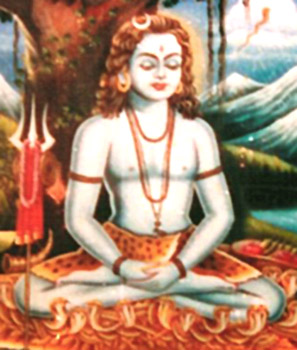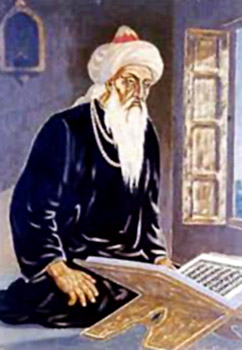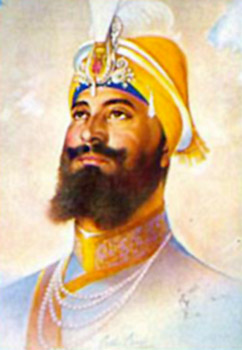 History of Punjabi literature can be traced a long way back. Broadly speaking, the evolution of Punjabi literature can be classified into three broad categories. These are as follows: Punjabi Literature from11th century to 16th century; Punjabi Literature from 16th century - 1849 and Modern Punjabi Literature (1850s onwards).
History of Punjabi literature can be traced a long way back. Broadly speaking, the evolution of Punjabi literature can be classified into three broad categories. These are as follows: Punjabi Literature from11th century to 16th century; Punjabi Literature from 16th century - 1849 and Modern Punjabi Literature (1850s onwards).
Early Punjabi Literature
The most ancient Punjabi literature was mainly spiritual in character and is found mainly in the remnants of the writings of the 11th century yogis Guru Gorakanath and Charpatnah. The literary convention and practice in Punjabi is generally conceived to commence with Fariduddin Ganjshakar (1173-1266), and of course later, Guru Nanak (1469-1539). Fariduddin Ganjshakar is deemed the "father" of Punjabi literature. One of the earliest texts of Punjabi literature is the Guru Granth Sahib or the Adi Granth. It was compiled not strictly in Punjabi but also in the Gurmukhi script. The various verses written by Fariduddin Ganjshakar encompassing such themes like the Almighty, the constant existence and realisation of death etc have all been splendidly amassed in the Adi Granth. Fariduddin Ganjshakar`s four hymns and 112 slokas are included in the Adi Granth. It is believed that with Guru Nanak, the first Sikh Guru, began the golden age of Sikh literature, and this period continued till the last Sikh Guru Gobind Singh. The works of this period are mostly religious in nature and deal with the life, works and philosophy of the Gurus. Janam Sakhis, Bachans, Sakhis, Goshts, Paramathas, Parchis and Uthankas are the various forms in which the prose of this period was written. His composition Japji Sahib emotes the essence of his teachings and is set in vigorous verses; the text is employed by the faithful as their daily meditation. The Janamsakhis (literally standing for `birth stories`) are chronicles on the life of Guru Nanak, penned soon after his demise and are excellent early instances of didactic prose in Punjabi literature.
 Punjabi literature acquired a solid body of work only from the end of the 16th century. Guru Gobind Singh (1666-1708), the tenth and last Guru, had composed a number of religious works mainly in Old Hindi with the exception of Candi-di-Var, which is in Punjabi. The birth of Khalsa or Sikhism is profoundly entwined with Punjabi poetry, as almost all the Sikh Gurus were accomplished poets/musicians and gave birth to stirring and heart-rending verses set to classical music, thus laying the foundation for new religious uttering combined with a quest for Punjabi identity. In a sense Guru Nanak was the first real `Punjabi` who gave its inhabitants a pride in reclaiming their separate identity within Punjabi literature.
Punjabi literature acquired a solid body of work only from the end of the 16th century. Guru Gobind Singh (1666-1708), the tenth and last Guru, had composed a number of religious works mainly in Old Hindi with the exception of Candi-di-Var, which is in Punjabi. The birth of Khalsa or Sikhism is profoundly entwined with Punjabi poetry, as almost all the Sikh Gurus were accomplished poets/musicians and gave birth to stirring and heart-rending verses set to classical music, thus laying the foundation for new religious uttering combined with a quest for Punjabi identity. In a sense Guru Nanak was the first real `Punjabi` who gave its inhabitants a pride in reclaiming their separate identity within Punjabi literature.
Middle Phase of Punjabi Literature
The period within 1600-1850 covers the entire Middle Punjabi literature. Hindu and Sikh writers wrote in Punjabi, but it were Muslims were the most creative in producing rich literature in Punjabi. There were a number of Muslim Sufi poets who came into the forefront during this time and their works formed an integral part of Punjabi literature. The best-known Hindu Punjabi scholar and Persian poet of the 17th century was Chandar Bhan of Lahore. In the 17th century Punjabi split up into three scripts - Perso-Arabic, Nagari and Gurmukhi. A Muslim poet named Abdullah`s (1616-1666) Bara Anva or the `the Twelve Topics` was written as a thesis on Islam. Bulle Shah (1680-1758) is the greatest Sufi poet whose Kafis or short poems of about six stanzas are very popular. Ali Haidar (1689-1776), one of his contemporaries, wrote a large number Si-harfis or poems of 30 stanzas, each stanza beginning with a letter of the Persian alphabet.
 Within the period of 1600 and 1850, precisely medieval Punjabi literature, Muslim Sufi, Sikh and Hindu writers had authored umpteen compositions in Punjabi. Punjabi Sufi literature was framed and penned by Shah Hussein (1538-1599) and Sultan Bahu (1628-1691), who wrote in the Kafi and the Si-harfi style respectively. Waris Shah`s interpretation of the tragic and immensely legendary love story of Heer Ranjha, is placed amongst the most popular medieval Punjabi works. Other popular tragic love stories from this period in Punjabi literature include - Sohni Mahiwal, Mirza Sahiba and Sassi Punnun. `Heroic poetry` (a form of verse composition also acknowledged as epic poetry), in literature of the Punjabis, included Guru Gobind Singh`s Chandi di Var and Najabat`s Nadir Shah Di Vaar. Shah Mohammad`s Jangnama is another outstanding instance of medieval heroic poetry, which lends an eyewitness account of the First Anglo-Sikh War that had taken place after the death of Maharaja Ranjit Singh.
Within the period of 1600 and 1850, precisely medieval Punjabi literature, Muslim Sufi, Sikh and Hindu writers had authored umpteen compositions in Punjabi. Punjabi Sufi literature was framed and penned by Shah Hussein (1538-1599) and Sultan Bahu (1628-1691), who wrote in the Kafi and the Si-harfi style respectively. Waris Shah`s interpretation of the tragic and immensely legendary love story of Heer Ranjha, is placed amongst the most popular medieval Punjabi works. Other popular tragic love stories from this period in Punjabi literature include - Sohni Mahiwal, Mirza Sahiba and Sassi Punnun. `Heroic poetry` (a form of verse composition also acknowledged as epic poetry), in literature of the Punjabis, included Guru Gobind Singh`s Chandi di Var and Najabat`s Nadir Shah Di Vaar. Shah Mohammad`s Jangnama is another outstanding instance of medieval heroic poetry, which lends an eyewitness account of the First Anglo-Sikh War that had taken place after the death of Maharaja Ranjit Singh.
Modern Punjabi Literature
Modern Punjabi literature is said to have commenced sometime in the late eighteenth and early nineteenth century. One of the major influences on Punjabi literature during this time was the colonial rule in India. Urdu language was adopted by the British as the medium of education within Punjab as a whole. Numerous striking and outstanding Punjabi poets and writers from the period accordingly began to pen in Urdu rather than Punjabi. A few of the stellar examples of poets in this genre include: Muhammad Iqbal (1877-1938); Faiz Ahmed Faiz (1911-1984); Saadat Hasan Manto (1912-1955); Krishan Chander (1914-1977); Rajinder Singh Bedi (1915-1984); Sahir Ludhianvi (1921-1980). Puran Singh (1881-1931). They had experimented with free verse and scouted the experiences of the common man and the downtrodden and under-privileged. Along the middle of the nineteenth century, the Christian missionaries gave a new outlook to Punjabi Literature. They issued and published a Punjabi translation of the Bible in 1852 and a Punjabi dictionary in 1854.
Modern Punjabi literature commences with the works of Bhai Vir Singh (1872-1957), who is described as the `Father of modern Punjabi literature`. He had composed numerous short poems (Lehran de Har, Matak Hutare and Bijlian de Har), biographies, novels (Sundari, Vijay Singh and Baba Naudh Singh) and dramas. One of Bhai Vir Singh`s most outstanbding works is Rana Surat Singh (1905), an extensive narrative poem in a blank verse form, named srikhandi chanda. Puran Singh (1882-1932), another great poet of this century who was credited with the title `Tagore of Punjab`, had introduced `free verse` into Punjabi and rendered into English a number of Punjabi poems by Bhai Vir Singh. Khule Lekh (1929) is the most classic specimen of his essays. Puran Singh`s contemporaries - Kirpa Singh (1875-1939) and Dhani Ram Chatrik (1876-1954) were the other prominent Punjabi poets, who focused upon secular poetry. Kirpa Singh had composed an epic, Lakshmi Devi, (1920) along the lines of Scott`s `The Lady of the Lake.` Dhani Ram Chatrik, whose works include Candan Vari, Himala, Ganga and Raa. Chatrik, was the pioneer of romantic poetry in Punjabi literature. Mohan Singh (1905-1978) is considered one of the most popular modern Punjabi poets. He had ushered in a modernistic outlook to Punjabi literature. His most renowned works comprise Sawe Pattar (1936) and Kasumbra (1937). Amrita Pritam (1919-2005) is one of the most celebrated poets of Punjabi literature. She had given rise to several intense works on the tragedy of the Partition like the poem Ajj Akhan Waris Shah Noo and her second novel Pinjar (1970). The period immediately after Independence is described as the `Amrita Pritam-Mohan Singh Era` of Punjabi poetry. Other noteworthy poets in Punjabi literature consist of: Pritam Singh Safir, Bawa Balwant, Santosh Singh Dhir, Takht Singh, Harbhajan Singh and Prabhjot Kaur.
Fiction in Punjabi literature had matured and bloomed under Nanak Singh (1897-1971), Vir Singh (1872-1957), Amrita Pritam (1919-2005), who described and framed on the experiences of women and on the partition of British India in 1947. Kartar Duggal was another stellar persona, who had explored the subjects of sexuality and sexual repression in his novels, short stories and plays. Other noted fiction writers in Punjabi literature include Jaswant Singh Kanwal, Narindarpal Singh, Surinder Singh Narula, Balwant Gargi, Jagjit Singh Anand, Ishwar Chitarkar, Suba Singh.
Thus discussed above is a brief history of Punjabi Literature.



















